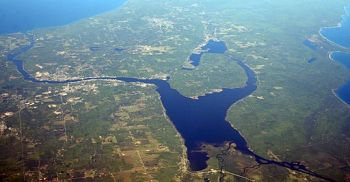Wetlands and Waterways

|
| Portage Lake on the Keweenaw Waterway in Michigan.
(Image Source: Wikipedia) |
What are "Waters of the United States"?
"The 1972 amendments to the Clean Water Act established federal jurisdiction over 'navigable waters,' defined in the Act as the 'waters of the United States' (CWA Section 502(7)). Many Clean Water Act programs apply only to 'waters of the United States.' The Clean Water Act provides discretion for EPA and the U.S. Department of the Army (Army) to define 'waters of the United States' in regulations."[1]
"40 CFR 230.3(s) indicates that the term 'waters of the United States' means:
- "All waters which are currently used, or were used in the past, or may be susceptible to use in interstate or foreign commerce, including all waters which are subject to the ebb and flow of the tide;
- "All interstate waters including interstate wetlands;
- "All other waters such as intrastate lakes, rivers, streams (including intermittent streams), mudflats, sandflats, wetlands, sloughs, prairie potholes, wet meadows, playa lakes, or natural ponds, the use, degradation or destruction of which could affect interstate or foreign commerce including any such waters:
- "Which are or could be used by interstate or foreign travelers for recreational or other purposes; or
- "(From which fish or shellfish are or could be taken and sold in interstate or foreign commerce; or
- "Which are used or could be used for industrial purposes by industries in interstate commerce;
- "All impoundments of waters otherwise defined as waters of the United States under this definition;
- "Tributaries of waters identified in paragraphs (s)(1) through (4) of this section;
- "The territorial sea;
- "Wetlands adjacent to waters (other than waters that are themselves wetlands).
"Waste treatment systems, including treatment ponds or lagoons designed to meet the requirements of CWA (other than cooling ponds as defined in 40 CFR 423.11(m) which also meet the criteria of this definition) are not waters of the United States.
"Waters of the United States do not include prior converted cropland. Notwithstanding the determination of an area’s status as prior converted cropland by any other federal agency, for the purposes of the Clean Water Act, the final authority regarding Clean Water Act jurisdiction remains with EPA."[1]
History of "Waters of the United States"
"'Waters of the United States' is a threshold term in the Clean Water Act and establishes the scope of federal jurisdiction under the Act. Clean Water Act programs, including Water Quality Standards, TMDLs, and sections 311, 402, and 404 address 'navigable waters,' defined in the statute as 'the waters of the United States, including the territorial seas.' "[1]
"The Clean Water Act does not define 'waters of the United States'; rather, it provides discretion for EPA and the U.S. Department of the Army to define 'Waters of the United States' in regulations."[1]
Best Practices Resources
![]() "Waters of the United States," Environmental Protection Agency (EPA)
"Waters of the United States," Environmental Protection Agency (EPA)
![]() Wetland and Waterbody Construction and Mitigation Procedures | Wetland and Waterbody Construction and Mitigation Procedures, FERC
Wetland and Waterbody Construction and Mitigation Procedures | Wetland and Waterbody Construction and Mitigation Procedures, FERC
Citations:
Revision ID: 7371
Revision Date: 07/21/2023
